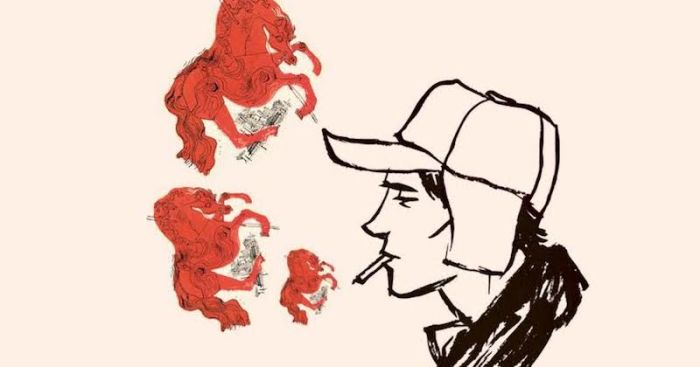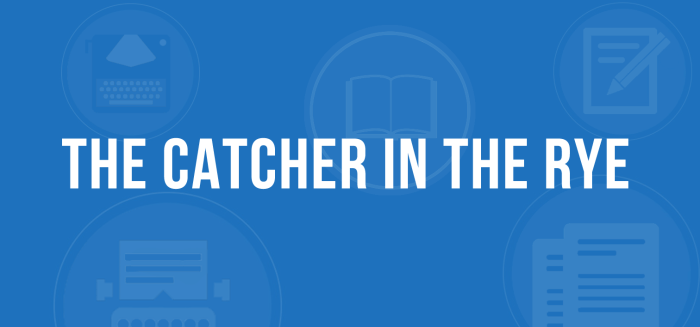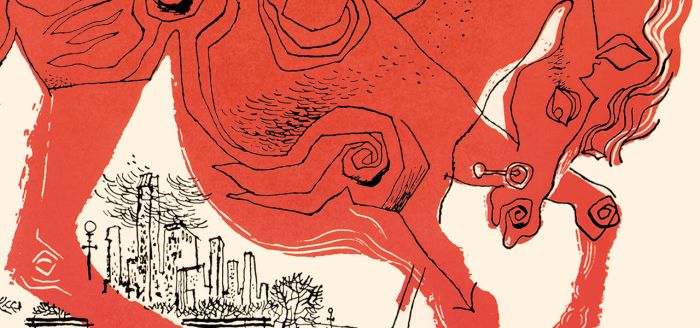Catcher in the rye literary elements – Delving into the literary elements of J.D. Salinger’s iconic novel, Catcher in the Rye, this exploration offers a captivating analysis of its complex characters, evocative setting, and profound themes, revealing the enduring significance of this American literary masterpiece.
Through an examination of Holden Caulfield’s introspective nature, the novel’s urban setting in 1950s New York City, and its exploration of alienation, innocence, and identity, this analysis provides a comprehensive understanding of Catcher in the Rye’s enduring appeal.
Characterization

Holden Caulfield, the protagonist of The Catcher in the Rye, is a complex and introspective teenager. He is intelligent, observant, and sensitive, but he is also cynical, alienated, and deeply troubled. Holden’s character is a reflection of the anxieties and disillusionment of adolescence, and his journey through New York City is a metaphor for his search for meaning and identity.
Holden’s relationships with other characters provide insights into his character. His sister, Phoebe, is the one person who truly understands him. She is intelligent, compassionate, and supportive, and she helps Holden to see the good in himself and the world.
Holden’s parents are well-intentioned, but they are also distant and uncommunicative. Holden feels like he cannot talk to them about his problems, and he resents their lack of understanding.
Use of Symbolism and Motifs
Salinger uses symbolism and motifs throughout the novel to explore Holden’s inner struggles. The red hunting hat that Holden wears is a symbol of his innocence and his desire to protect himself from the adult world. The ducks in Central Park represent Holden’s longing for a simple and carefree life.
The carousel is a symbol of Holden’s desire to go back to a time when he was happy and carefree.
Setting
The novel’s setting in New York City during the 1950s is crucial to its narrative and thematic development. The urban environment shapes Holden Caulfield’s experiences and perceptions, providing a backdrop against which his alienation and disillusionment unfold.
The City’s Impact on Holden
- The city’s fast-paced, materialistic atmosphere amplifies Holden’s sense of isolation and insignificance.
- The superficiality and phoniness he encounters in society disillusion him and lead him to question the values of the adult world.
- The city’s anonymity allows Holden to explore his identity and search for genuine connections.
Contrast between City and Idealized World
The novel juxtaposes the gritty reality of New York City with Holden’s idealized world of innocence and authenticity. This contrast highlights the protagonist’s struggle to reconcile his romantic notions with the harsh realities of life.
- The city’s corruption and materialism clash with Holden’s desire for purity and honesty.
- The novel’s depiction of childhood innocence and the loss thereof underscores the challenges of navigating the complexities of the adult world.
- Holden’s longing for a simpler time and place reveals his yearning for a world that aligns with his values.
Plot

The novel follows Holden Caulfield, a teenage boy who runs away from prep school and spends three days in New York City. During this time, Holden has a series of encounters with different people, including his younger sister, Phoebe, his former English teacher, Mr.
Antolini, and a prostitute named Sunny. These encounters force Holden to confront his own feelings of loneliness, alienation, and disillusionment with the adult world.
Use of Flashbacks and Stream-of-Consciousness
Holden’s journey of self-discovery is conveyed through the use of flashbacks and stream-of-consciousness. Flashbacks allow Holden to revisit his past experiences and explore how they have shaped his present. Stream-of-consciousness allows Holden to express his thoughts and emotions in a raw and unfiltered way, providing readers with a deep insight into his inner world.
Impact of Holden’s Encounters
Holden’s encounters with different people have a profound impact on his understanding of the world. His sister, Phoebe, represents innocence and hope, while Mr. Antolini represents the wisdom and experience of the adult world. Sunny represents the corruption and disillusionment that Holden finds in the adult world.
These encounters force Holden to confront his own beliefs and values, and to question the world around him.
Themes
The Catcher in the Rye explores a myriad of themes that resonate with readers of all ages and backgrounds. Central to the novel are the themes of alienation, innocence, and the search for identity.
The protagonist, Holden Caulfield, embodies the theme of alienation. He feels isolated and disconnected from society, which he perceives as superficial and corrupt. His alienation manifests in his cynical attitude towards adults and his desire to escape from the expectations and norms of the adult world.
Innocence
Holden’s alienation is intertwined with the theme of innocence. He clings to his childhood innocence and idealism, even as he witnesses the hypocrisy and corruption of the adult world. His desire to protect children from the harsh realities of life reflects his own longing for a simpler, more innocent time.
Search for Identity
Holden’s alienation and search for innocence are also tied to his struggle for identity. He is at a crossroads in his life, trying to figure out who he is and where he belongs. His journey of self-discovery leads him to question societal norms and expectations, as he grapples with his own values and beliefs.
Symbolism and Motifs: Catcher In The Rye Literary Elements

The Catcher in the Ryeis replete with symbols and motifs that contribute to its richness and depth. These symbols and motifs are woven into the narrative, adding layers of meaning and inviting readers to contemplate the novel’s themes.
The Red Hunting Hat
The red hunting hat is a recurring symbol throughout the novel. It represents Holden’s longing for innocence and his desire to escape the phoniness of the adult world. The hat is a physical manifestation of Holden’s desire to protect himself from the harsh realities of life.
The Ducks in Central Park
The ducks in Central Park symbolize Holden’s search for stability and permanence in a changing world. The ducks represent the natural world, which Holden sees as pure and unchanging, in contrast to the artificiality and phoniness of the human world.
The Museum of Natural History
The Museum of Natural History represents Holden’s desire to understand the world around him. He is fascinated by the exhibits on animals and natural history, which represent the order and predictability of the natural world. The museum provides Holden with a sense of comfort and stability in a world that he finds confusing and overwhelming.
Table of Symbols and Significance
The following table summarizes the symbols and their significance in The Catcher in the Rye:
| Symbol | Significance |
|---|---|
| Red hunting hat | Holden’s longing for innocence and escape from phoniness |
| Ducks in Central Park | Holden’s search for stability and permanence |
| Museum of Natural History | Holden’s desire to understand the world around him |
Literary Style
J.D. Salinger’s The Catcher in the Ryestands out for its unique literary style that combines slang, colloquialisms, and profanity, mirroring the voice of a teenage narrator. This distinctive style contributes to the novel’s authenticity and relatability, immersing readers in the world of Holden Caulfield.
Holden’s Unreliable Narration
Holden’s narration is unreliable, often reflecting his own biases and emotional state. This unreliability prompts readers to question the accuracy of events and characters, challenging them to form their interpretations. The novel’s structure as a series of vignettes further emphasizes this unreliability, as readers piece together Holden’s fragmented memories and observations.
Cultural Impact
The Catcher in the Ryehas had a profound and lasting impact on American literature and culture. Its unique voice, exploration of adolescent alienation, and critique of societal hypocrisy have resonated with generations of readers.
Controversy
The novel has been the subject of controversy since its publication due to its themes of rebellion, sexual exploration, and profanity. It has been banned or challenged in schools and libraries, but it has also been praised for its honesty and authenticity.
Influence on Subsequent Generations, Catcher in the rye literary elements
The Catcher in the Ryehas influenced subsequent generations of writers and readers. Its portrayal of Holden Caulfield’s alienation and search for meaning has inspired characters and themes in works by J.D. Salinger’s contemporaries and successors, including Jack Kerouac, Philip Roth, and Bret Easton Ellis.
The novel’s exploration of adolescent angst and the complexities of identity formation has also resonated with young readers, who continue to find solace and inspiration in Holden’s journey.
Question Bank
What is the significance of Holden Caulfield’s characterization in Catcher in the Rye?
Holden Caulfield is a complex and introspective protagonist whose journey of self-discovery drives the narrative. His alienation, youthful idealism, and search for authenticity make him a relatable and enduring literary figure.
How does the setting of New York City shape Holden’s experiences in the novel?
The urban environment of 1950s New York City provides a backdrop for Holden’s encounters with a variety of characters and situations, shaping his perceptions of the world and contributing to his disillusionment.
What are the central themes explored in Catcher in the Rye?
The novel explores themes of alienation, innocence, identity, and the search for meaning. Holden’s journey highlights the challenges of adolescence, the complexities of human relationships, and the desire for authenticity in a world perceived as superficial.